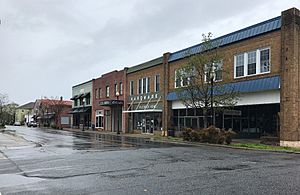Columbia, North Carolina facts for kids
Quick facts for kids
Columbia, North Carolina
|
||
|---|---|---|

Main Street in Columbia
|
||
|
||

Location of Columbia, North Carolina
|
||
| Country | United States | |
| State | North Carolina | |
| County | Tyrrell | |
| Area | ||
| • Total | 1.24 sq mi (3.23 km2) | |
| • Land | 1.23 sq mi (3.18 km2) | |
| • Water | 0.02 sq mi (0.05 km2) | |
| Elevation | 3 ft (0.9 m) | |
| Population
(2020)
|
||
| • Total | 610 | |
| • Density | 496.74/sq mi (191.75/km2) | |
| Time zone | UTC-5 (Eastern (EST)) | |
| • Summer (DST) | UTC-4 (EDT) | |
| ZIP code |
27925
|
|
| Area code(s) | 252 | |
| FIPS code | 37-13940 | |
| GNIS feature ID | 2406300 | |
| Website | www.townofcolumbianc.com | |
Columbia is a small town in Tyrrell County, North Carolina, United States. It is the main town, also called the county seat, of Tyrrell County. In 2020, about 610 people lived there.
Contents
Geography of Columbia
Columbia is located in northeastern North Carolina. It is part of a larger area known as the Albemarle-Pamlico Peninsula. This area is found inland from the famous Outer Banks.
The town is surrounded by water. To the north is Albemarle Sound. The Alligator River is to the east. The Scuppernong River is to the west. The town itself covers about 3.23 square kilometers (1.24 square miles) of land.
History of Columbia
Tyrrell County was named after Sir John Tyrrell. He was one of the original owners of the Carolina colony. The county used to be much larger. It stretched from Roanoke Island all the way to Tarboro.
In 1870, the county was divided into smaller parts. These new counties included Tyrrell, Martin, Washington, and Dare. Columbia, which was first called Elizabethtown, was founded in 1793. It sits on the banks of the Scuppernong River. In 1799, it became the main town for Tyrrell County.
Somerset Place Historic Site
Near Columbia, you can find Somerset Place State Historic Site. This was a large plantation that started in 1785. From 1829, it was home to the Collins family. It was also home to over 300 enslaved African American people. Their lives and work are remembered and explained at this site. Somerset Place helps us understand what plantation life was like a long time ago.
Early Newspaper
The first newspaper in Columbia was called the Eagle. The last known issue of this newspaper was printed on April 1, 1943.
Historical Sites
Columbia also has important archaeological sites. Some of these are listed on the National Register of Historic Places. This means they are important historical places.
People in Columbia (Demographics)
| Historical population | |||
|---|---|---|---|
| Census | Pop. | %± | |
| 1880 | 166 | — | |
| 1890 | 209 | 25.9% | |
| 1900 | 382 | 82.8% | |
| 1910 | 848 | 122.0% | |
| 1920 | 738 | −13.0% | |
| 1930 | 864 | 17.1% | |
| 1940 | 1,090 | 26.2% | |
| 1950 | 1,161 | 6.5% | |
| 1960 | 1,099 | −5.3% | |
| 1970 | 902 | −17.9% | |
| 1980 | 758 | −16.0% | |
| 1990 | 836 | 10.3% | |
| 2000 | 819 | −2.0% | |
| 2010 | 891 | 8.8% | |
| 2020 | 610 | −31.5% | |
| U.S. Decennial Census | |||
2020 Census Information
In 2020, there were 610 people living in Columbia. These people lived in 338 households. About 197 of these households were families.
The table below shows the different groups of people living in Columbia:
| Group | Number | Percentage |
|---|---|---|
| White (not Hispanic) | 192 | 31.48% |
| Black or African American (not Hispanic) | 248 | 40.66% |
| Asian | 3 | 0.49% |
| Other/Mixed | 17 | 2.79% |
| Hispanic or Latino | 150 | 24.59% |
Famous Person
- Brian Rowsom is a person from Columbia. He used to be a player in the NBA.
See also
 In Spanish: Columbia (Carolina del Norte) para niños
In Spanish: Columbia (Carolina del Norte) para niños


